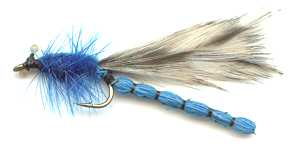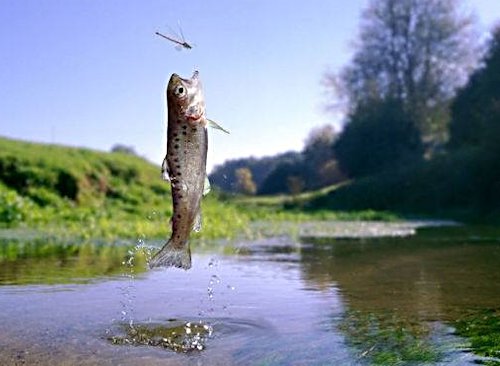The Blue Damsel Dry Fly
The Blue Damsel Flyfishing Dry Fly pattern for trout fishing are slim and elegant. All though not a true mayfly it has a number of the same characteristics: having a nymph stage that heads to the surface but also towards the shallower waters near the shore.

DRY FLY PATTERNS. Hook size 10 12 - $US each
The mature Damsel nymphs have a very distinctive wriggling motion. They make very tempting targets for hungry trout as they migrate in large numbers to above water objects. Trout gorge themselves on the migrating nymphs and they can provoke a feeding frenzy. It hatches a lot later in the year than the other upwinged duns and spinners. The adult damselfly comes in a number of colors but the most common is the blue. At times of mating they fly very low over the water surface and are grabbed by the fish. During mating the coupled flies land on any convenient emergent vegetation, down which the female walks to lay her eggs underwater. They belong to the Zygoptera group of insects. They are closely related to dragon flies but are much more numerous.
You really know that summer is coming when you see your first iridescent blue body of a Common Blue Damsel fly being propelled through the air by its fast lace wings. They mainly prefer the smaller lakes and ponds rather than the large open stillwaters, but I have seen quite a few patrolling the banks of the Blagdon and Bewl Water reservoir. After hatching Blue Damsels cling onto bank side vegetation to gain strength before taking to the air for the first time. I have caught brown trout and rainbows by casting near aquatic plants, low lying branches, bushes and grass, I then allow the pattern to drift into them. I have also observed that many of the adult Blue Damsels seem to fly only a few inches above the water surface. They fly mainly in straight lines but slightly pause before changing direction. I have seen Trout pop out of the water with their mouths open and grab the unsuspecting aerial blue aviator. I have mimicked this with success by retrieving a Blue Damsel fly near a lurking fish and pause before changing direction. This pattern offers a decent size meal to the trout. It is worth the extra expense of energy to them if the reward is so good.

The Damsel Nymph is the largest subsurface insect that a fly fishing angler tries to imitate. To a hungry predatory trout it is the equivalent of McDonalds Big Mac and fries. Damsel nymphs are a member of the Odonata family of insects. This group is more commonly known as dragon Flies and the adults vary in colour and can be the size of a man’s hand. A sub-order is called Zygoptera and these are known as Damsel flies. The adults are normally smaller than their bigger brother dragon flies. Scientists have found that damsels form a substantial part of a trout’s diet especially in the larval stage and as they hatch into adults. If you take your kids or young nephews to a Natural History museum that exhibits fossils then you may be able to find examples of them preserved in the rocks. These insects are ancient. Some have been found in Jurassic period fossils from 140 million years ago.
They are a species that is found all over the world. To illustrate their life cycle I will talk about two that are found in the British Isles; the Common Blue Damsel and the Red-eyed Damsel. The Common Blue Damsel can be found in the southern English chalk hill rivers like the Test and Itchen as well as in the northern Scottish Lochs. The Red-eyed Damsel limits its range to the south coast of England and up to central midlands.

Both insects will tolerate a variety of habitats from crystal clear mountain rivers and streams with gravel beds, lakes and garden ponds. Their numbers can be reduced if the water source gets polluted or the vegetation under the water and along the lake or river bank becomes sparse. The female damsels lay their eggs on aquatic plants below the water surface. The female has a sharp incisor at the end of her tail. She uses this to make a cut into the tissue of the plant. The cylindrical shaped eggs are then inserted into this opening. The females are at risk of being taken by lurking trout at this stage. A weighted adult dry fly Damsel pattern drifted past aquatic vegetation can bring good results if you observe female damsels laying eggs.
The time it takes for the eggs to hatch depends on the Damsel species. They range from one to three weeks. Unlike other aquatic insects, the eggs do not all hatch at the same time. Damsel nymphs hatch piecemeal to help improve their survival rate. It may take over a week for all the eggs in one batch to hatch. Many male insects die after mating. Not so with the adult male damsel fly. He will try to mate with as a many females as he can. The males only live for a few days so they try to enjoy themselves as much as they can.
The larval stage of the Red-eyed and Common Blue Damsel is completed under water. They develop by moulting there outer skin, called the cuticle, as they put on weight and get bigger. These moults are called instars. Damsel nymphs are active hunters and move along the river and lake bottoms looking for prey to kill and munch. The moults occur in open water, normally in or near vegetation. They are particularly vulnerable to predation by trout at this stage in their life. This development pattern is very different to that of the upwinged Mayfly family of insects, who remain buried in the debris and silt for most of their nymphal stage.
Damsel Larvae crawl along the river bed to hunt but also use their long tail to swim in a snake like motion. The marabou tail of the Damsel nymph fly pattern imitates this feature as it is retrieved through the water. When you are fishing with a damsel nymph fly pattern think about how it moves. A fast retrieve will result in an unnatural action that will scare away the trout. They do not expect their insect food to suddenly develop superpowers. Short jerky movements with the odd pause will produce more takes as it mimics the movement of the real insect exploring the gravel and vegetation debris as it looks out for smaller unsuspecting insects to eat.
When the damsel nymphs perceive they are under threat from a large fish, they suddenly stop swimming and drop to the river bed. You can copy this natural movement by using a sink and draw technique; retrieve your nymph and then pause to let it sink lower in the water. Then try again after a short wait. In clear water try to get your fly in front of an approaching trout. As it gets near, pause and let your fly sink. As it is nearly on top of your fly give your line a quick jerky pull of about six inches, to imitate the damsel nymph panicking whilst trying to escape and watch the sport.
Damsel nymphs remain underwater normally for a year. They continue to feed, grow, moult, feed, grow, moult until they have reached the size and maturity to proceed to the next stage in their life cycle. The Common Blue Damsel nymph in the far north may take two years to become mature due to cold water temperatures and the lack of food. On the final instar moult the insect’s wing buds and compound eyes are formed.
When it feels ready to hatch the larval nymph looks around for a suitable piece of vegetation that is hanging down into the water or growing up through the water surface into the air. It will then climb to the surface and finally emerge into an adult. Some will crawl clear of the water’s edge and hatch on the river bank or lake side. They are susceptible to predation by frogs, spiders and birds during this period.
Their wings must stiffen before they fly off for the first time. The wings must fill with blood and this can take 30 minutes. Their first flight is not confident. They seek the safety of a tree or nearby bush where they can hide as they rest before further flying attempts. The adult female Damsel flies are not sexually mature as soon as they hatch unlike the males. They have to feed and develop first. This may take one to three weeks depending on the amount of food and weather conditions. The Common Blue Damsel likes to follow airborne insects and take them in flight. The Red-eyed damsel prefers to ambush its prey by finding a suitable location where it can leap off and grab passing insects. Both also patrol plants and trees for aphids.
Adult Damsels are prone to attack by birds as they are brightly coloured, big and relatively slow flyers. This is especially so when they stop and hover. As a defense they can often be seen flying and hovering close to the water surface. Unfortunately for the adult damsel there is an unseen danger lurking under the water. These surface skimming antics are visible to upward looking trout. Some are taken by leaping open mouthed fish. The trout have to be very fast otherwise their intended flying prey will escape. They are more successful taking females during egg laying.
After mating the Common Blue Damsel break their love making embrace and the female descends into the water along her chosen partly submerged leaf or plant stem. This is when many are taken by trout. The red-eyed damsel male and females stay in their tandem mating position whilst the both crawl under the water surface. Some go down three feet. This is a more tempting target as in one mouthful a trout will score two damsels at the same time. After egg laying many females fail to break through the water surface film because in their weakened state it can be a strong barrier. They drown and become fish food. A "drowned" adult dry fly can stimulate a number of takes if fished near vegetation when mating damsels are seen resting on plants.

Fly Fishing books

